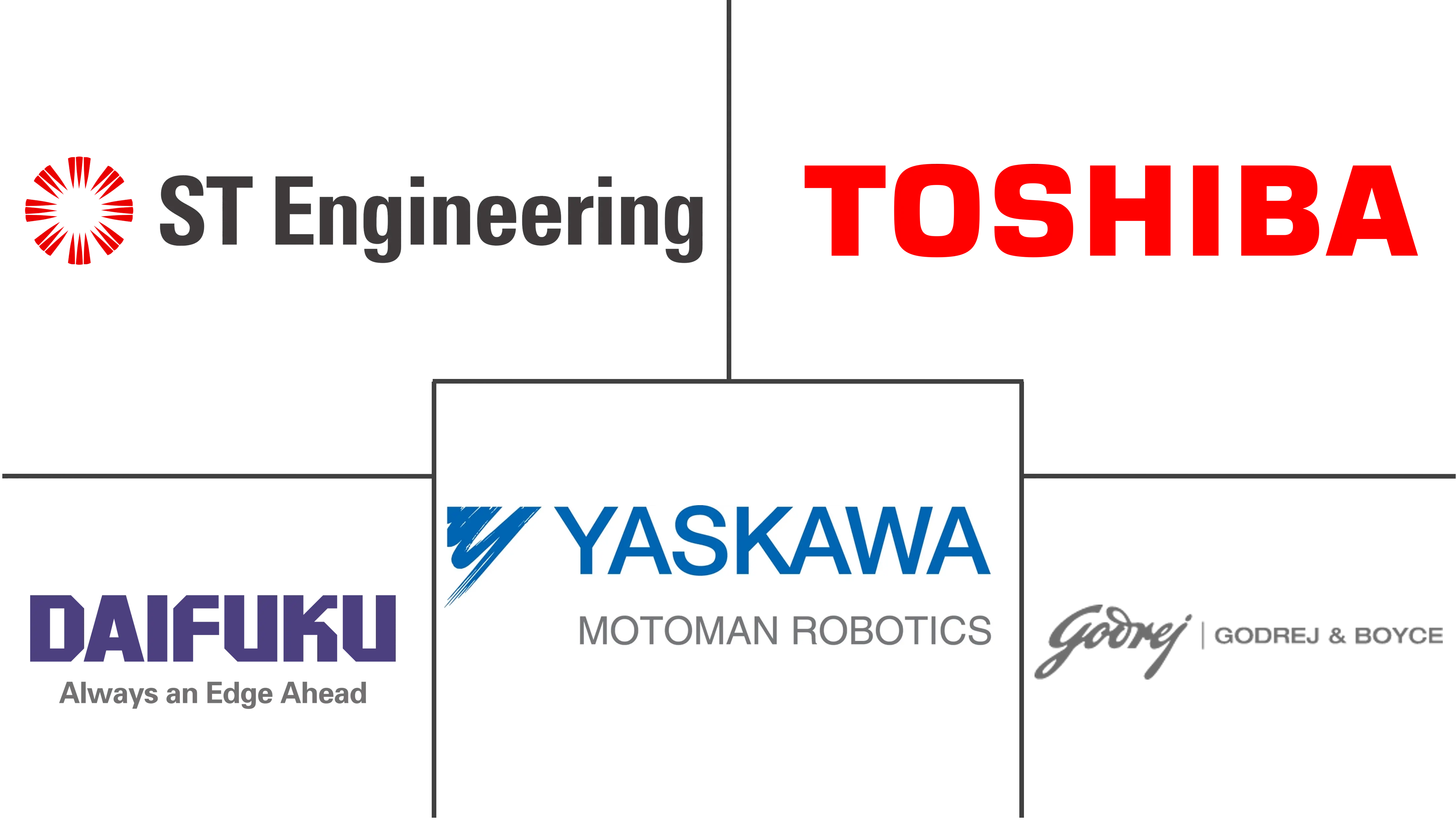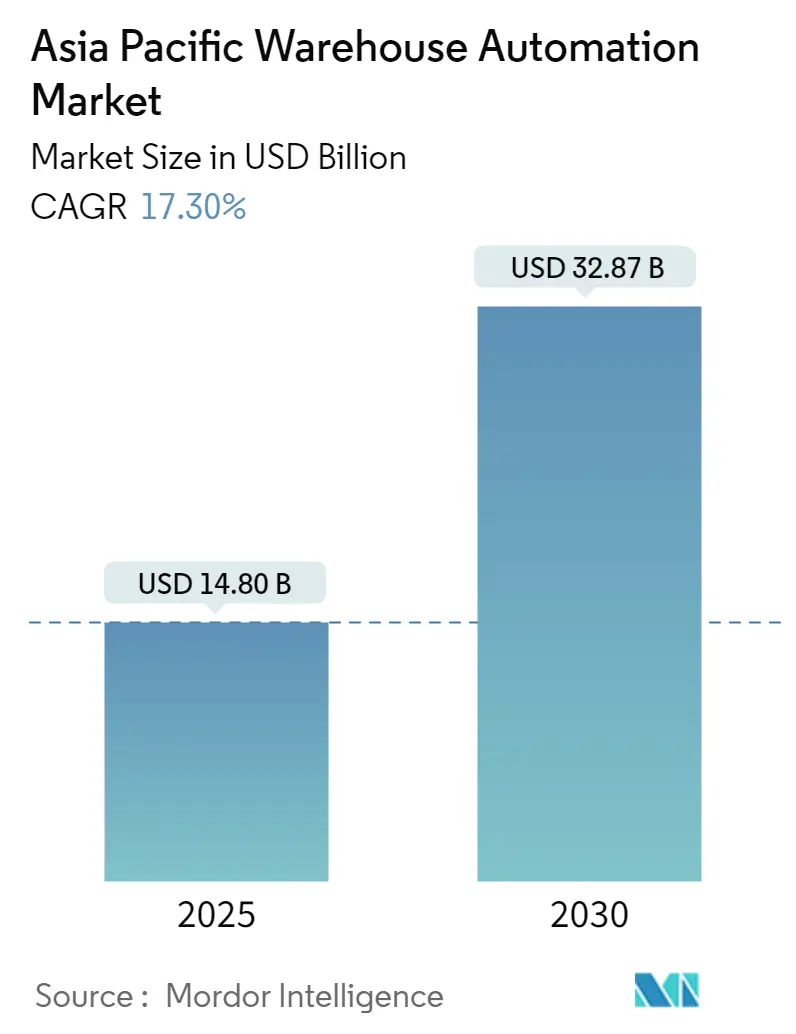
Asia Pacific Warehouse Automation Market Analysis by Mordor Intelligence
The Asia Pacific Warehouse Automation Market size is estimated at USD 14.80 billion in 2025, and is expected to reach USD 32.87 billion by 2030, at a CAGR of 17.3% during the forecast period (2025-2030).
The COVID-19 pandemic, which wreaked havoc on major economies such as China, Japan, and India, is predicted to impact future market growth. Significant investments are influencing the rise of roller conveyors in the Asia-Pacific in the e-commerce industry and demand from ever-increasing internet-enabled consumers.
Furthermore, with large investments in the industry, the manufacturing sector is predicted to account for a significant market share and become one of the country's major contributors. The requirement to deliver varied products in short durations has grown, necessitating efficient inventory management and reverse logistics systems.
- The expansion of the Asia-Pacific warehouse automation market is examined by looking at India, China, Australia, South Korea, Japan, and the rest of Asia. China, one of the world's major economies, is continually creating and deploying warehouse robots. China is expected to have a significant share in the market. As a result of the high automation rates, the presence of prominent vendors, and the widespread availability of warehouse robots, China's demand for warehouse robotics is significant.
- Due to the rise of the manufacturing, retail, and FMCG industries, there is an ever-increasing demand for industrial automation solutions across the APAC region. Shuttle retrieval systems, as well as automated storage and mobile robot platforms, are seeing a significant increase. Industrial and freight routes are sprouting up throughout the region, increasing the number of organized participants in the storage and industrial parks.
- Moreover, According to a 2022 study on warehouse vision conducted by Zebra Technologies, For the survey, more than 1,500 warehouse decision-makers and colleagues were polled from Australia, China, India, Japan, and Singapore. According to the survey, 27% of warehouse operators worldwide, including those in APAC, have already employed autonomous mobile robots (AMR). This ratio is expected to climb to 92% in APAC and 90% internationally in the next five years.
- While most warehouses will employ AMRs for P2G picking, material movements, and other automated inventory moves, more will invest in software that automates analytics and decision-making. In APAC, 95% of decision-makers expressed willingness to invest in such software to improve worker effectiveness and efficiency while lowering labor costs, slightly exceeding the global average (94%).
- Additionally, companies in the region are hurrying to adopt warehouse automation across the region in the wake of the COVID-19 outbreak. According to Mobile Industrial Robots in Shanghai, China, the company's autonomous robots that can transport pallets and large loads around warehouses and factories have seen growing demand across a wide range of industries. Airbus, Flex, Honeywell, and DHL are the major firms responsible for the rising demand.
Asia Pacific Warehouse Automation Market Trends and Insights
Automated Guided Vehicles (AGVs) is Expected to Have a Significant Growth
- The major application of mobile robots is in mobile automated guided vehicles (AGVs) that transfer items across APAC in warehouses and storage facilities. These robots follow pre-programmed paths, transporting things for transportation and storage 24 hours a day, seven days a week. AGVs are vital for lowering logistical costs and streamlining the supply chain.
- In addition to replenishing and picking, AGVs are used in inbound and outbound handling. AGVs, for instance, are used to move inventory from receipt to storage or from long-term storage to forward-picking locations to restock stock. Moving inventory from long-term storage to forward-picking locations guarantees enough inventory is available to selectors, resulting in a more effective order-picking process.
- The APAC warehouse landscape is evolving, with more automation and manual labor optimization used to cut costs and boost profits. Workers in a warehouse should spend their human intelligence on more value-adding activities while the robots step in and take care of efficiency mapping and waste reduction to produce a smooth flow.
- For instance, GreyOrange announced patents in September 2020 for technology critical for businesses to achieve high-yield omnichannel fulfillment and maximize facility space utilization through multilayer operation capabilities. First-to-Fill Technology, Retail-Ready Fulfilment, and Multilevel Robot Mobility are all covered by the patents.
- Robotics has become crucial to the profitability of several end users. The AMRs are leading the way since they are critical for quick, secure, and error-free delivery, a quick time to market, lower costs, and end-to-end trackability. The degree of autonomy distinguishes autonomous mobile robots (AMRs) from autonomous ground vehicles (AGVs).
- DHL established the Asia Pacific Innovation Center in Singapore in October 2021 as a showcase for new displays showcasing a cutting-edge, automated, and fully integrated e-commerce system. Geek+ announced a relationship with DHL to exhibit some of the company's greatest inventions at the Asia Pacific Innovation Center. Geek+ and DHL will demonstrate the future of warehouse robot automation.
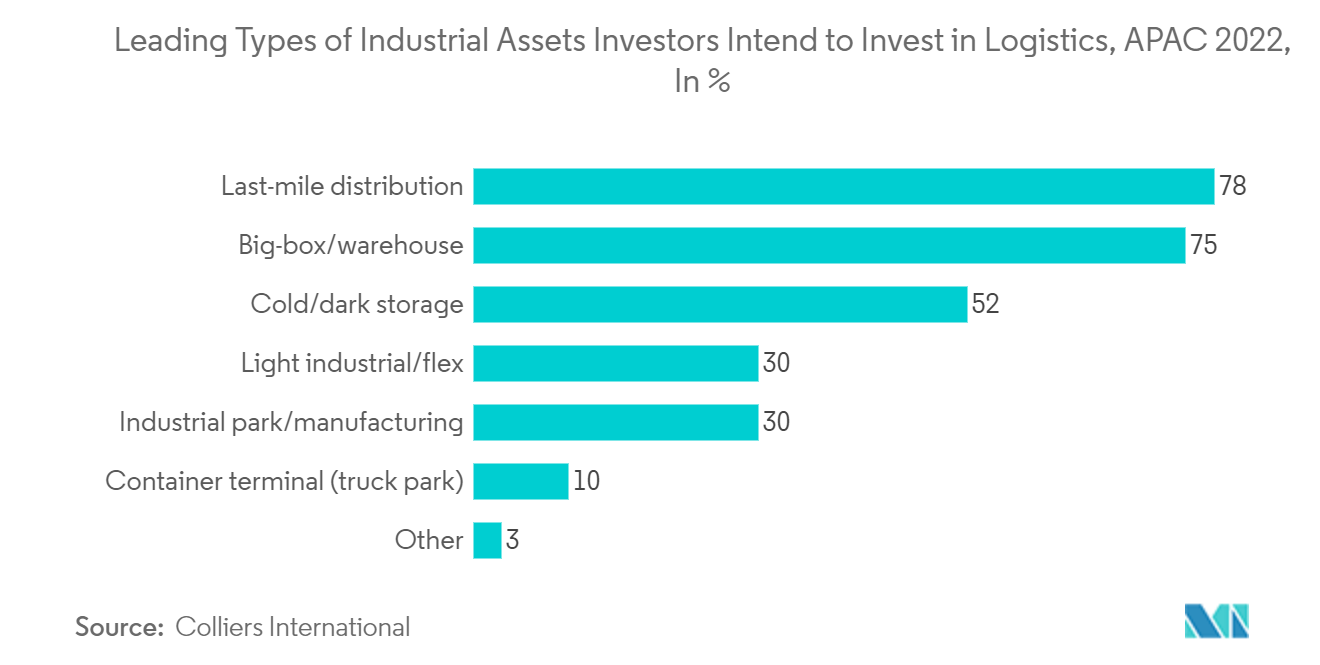
India is Expected To Witness High Growth In The Asia-Pacific Warehouse Automation Market
- The warehousing industry in India is undergoing a considerable transformation to keep pace with the country's growing manufacturing sector and massive logistics industry. The warehouse industry is expected to benefit significantly from adopting the goods and services tax and real estate investments. Instead of the current scattered and standalone facilities, GST would ensure that India sees a vast, consolidated area with central warehousing parks for the first time.
- Furthermore, India's adoption of e-commerce has resulted in a tremendous increase in business for the warehousing industry. This rapid expansion has brought with it a slew of new obstacles. Transportation delays, a shortage of experienced labor, and other factors prompted stakeholders to look beyond traditional tactics in favor of robotics-enabled automation systems.
- For instance, e-commerce giant Amazon, which plans to invest USD 5.0 billion in India, is focusing on automated warehouses around the country. It opened several new warehouses to serve a variety of customers. Amazon was one of the first few Indian corporations to experiment with and implement robotics in its warehouses.
- Also, India's warehouse landscape is evolving, with more automation and manual labor optimization used to save costs and boost profits. Workers in a warehouse should spend their human intelligence on more value-adding activities while the robots step in and take care of efficiency mapping and waste reduction to produce a smooth flow. Robotics has become crucial to multiple end users' profitability.
- Atmos Systems, India, a prominent name in warehouse automation, announced the Atmos A42N, an autonomous case handling robotic (ACR) system that can greatly improve a warehouse's inbound and outgoing efficiency in December 2021. The system is packed with user-friendly features, allowing greater warehouse location flexibility.
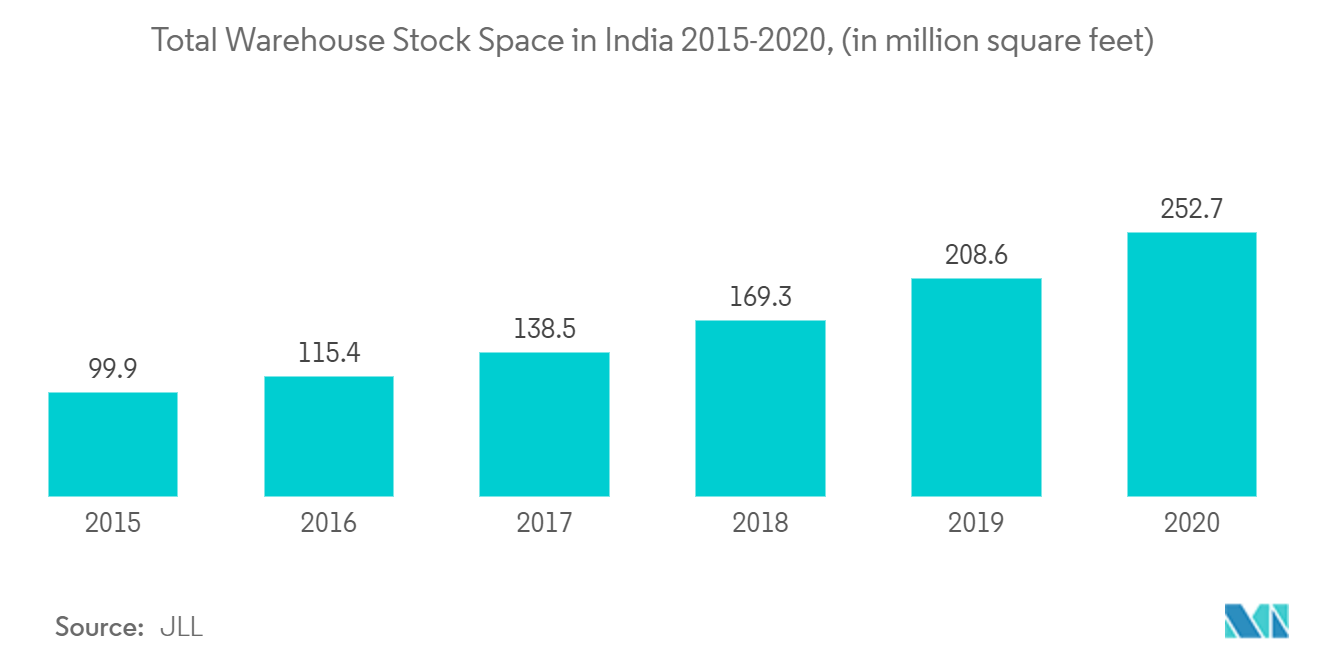
Competitive Landscape
The APAC warehouse automation market is moderately competitive and fragmented, with many global and regional players holding significant market shares. To maintain their market share, corporations will continue to innovate and form strategic collaborations. ST Engineering, Toshiba Global, Yaskawa Electric Corporation (Yaskawa Motoman), Daifuku Co., Ltd., Grey Orange, Godrej Consoveyo Logistics Automation Ltd. (GCLA), and others are some of the prominent players in this market.
- May 2022 - SYNUS Tech, a logistics automation firm, and Attabotics, the first 3D robotics supply chain system for modern commerce, established an exclusive cooperation today to provide integrated logistics system warehousing solutions to the South Korean markets. SYNUS Tech is developing smart industrial solutions and integrating AI into warehouses for the first time in Korea, thanks to partners like Attabotics.
- February 2022 - Addverb Technologies, India is pushing its warehouse robotics product suite to the North American market after acquiring USD 132.0 million. With its fleet of automated robots, material handling technology, system integration services, and software solutions, Addverb will help improve the performance and precision of warehouse and industrial operations.
- August 2020 - Murata Machinery has agreed to build Japan's first 3D robot warehousing system, "ALPHABOT," in collaboration with Alpen Co. Ltd. ALPHABOT will be installed at the Alpen Komaki Distribution Center, one of Alpen Group's key distribution centers, to increase storage capacity and cut picking, sorting, and packaging procedures by about 60%. The system was started in July 2021.
Asia Pacific Warehouse Automation Industry Leaders
ST Engineering
Toshiba Global
Yaskawa Electric Corporation (Yaskawa Motoman)
Daifuku Co., Ltd.
Godrej Consoveyo Logistics Automation Ltd. (GCLA)
- *Disclaimer: Major Players sorted in no particular order
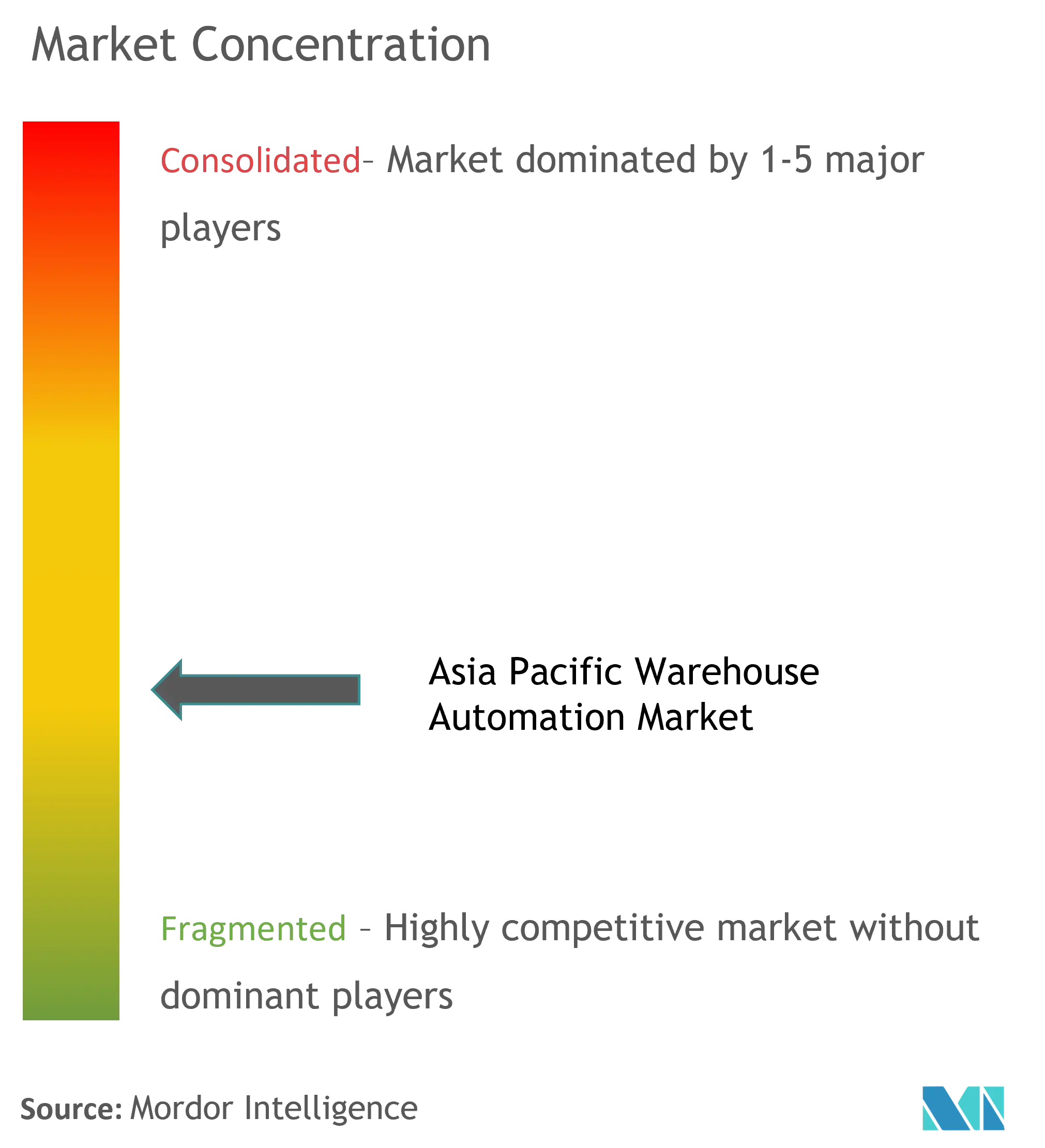
Recent Industry Developments
- October 2021 - DHL created the Asia Pacific Innovation Center in Singapore as a home for new exhibits that showcase a cutting-edge, automated, and completely integrated e-commerce solution. At the Asia Pacific Innovation Center, Geek+ announced a collaboration with DHL to exhibit some of the latest innovations from Geek+. Geek+ and DHL will showcase the future of robotics automation in warehouses.
- June 2020 - Cohesio Group, part of Körber Supply Chain, has announced it has formed a partnership with the autonomous mobile robot (AMR), Fetch Robotics, to help retailers and logistics providers in APAC achieve productivity gains of upwards of 200%. The two leading providers will collaborate to deliver advanced automation through flexible and scalable solutions for retailers and logistics providers in APAC.
- March 2020 - Aurionpro Solutions Ltd, a supply chain solution provider known for its software services for cold storage, has announced the onboarding of India-based cold chain service provider ColdrushLogistics to assist them in developing compliant warehouse procedures and warehouse management.
Asia Pacific Warehouse Automation Market Report Scope
The Asia Pacific warehouse automation market study involves segmentation by component wherein hardware (AGV/AMR, AS/AR, piece picking, etc.), software (warehouse management systems, warehouse execution systems), and services (value-added services, maintenance, etc.) sub-segments are being analyzed.
Further, the warehouses and fulfillment centers perform activities across end-users, such as food and beverages, post and parcel, apparel, general merchandise, and manufacturing, to name a few. The manufacturing industry majorly includes the automotive, electronics, and pharmaceutical sectors. The study also provides the impact of COVID-19 on the market studied.
| Hardware | Mobile Robots (AGV, AMR) |
| Automated Storage and Retrieval Systems (AS/RS) | |
| Automated Conveyor & Sorting Systems | |
| De-palletizing/Palletizing Systems | |
| Automatic Identification and Data Collection (AIDC) | |
| Piece Picking Robots | |
| Software (Warehouse Management Systems(WMS), Warehouse Execution Systems (WES)) | |
| Services (Value Added Services, Maintenance, etc.) |
| Food and Beverage (Including Manufacturing Facilities and Distribution Centers) |
| Post and Parcel |
| Groceries |
| General Merchandise |
| Apparel |
| Manufacturing (Durable and Non-Durable) |
| Other End-user Industries |
| China |
| India |
| Japan |
| Rest Asia-Pacific |
| Component | Hardware | Mobile Robots (AGV, AMR) |
| Automated Storage and Retrieval Systems (AS/RS) | ||
| Automated Conveyor & Sorting Systems | ||
| De-palletizing/Palletizing Systems | ||
| Automatic Identification and Data Collection (AIDC) | ||
| Piece Picking Robots | ||
| Software (Warehouse Management Systems(WMS), Warehouse Execution Systems (WES)) | ||
| Services (Value Added Services, Maintenance, etc.) | ||
| End-User | Food and Beverage (Including Manufacturing Facilities and Distribution Centers) | |
| Post and Parcel | ||
| Groceries | ||
| General Merchandise | ||
| Apparel | ||
| Manufacturing (Durable and Non-Durable) | ||
| Other End-user Industries | ||
| Country | China | |
| India | ||
| Japan | ||
| Rest Asia-Pacific |
Key Questions Answered in the Report
How big is the Asia Pacific Warehouse Automation Market?
The Asia Pacific Warehouse Automation Market size is expected to reach USD 14.80 billion in 2025 and grow at a CAGR of 17.30% to reach USD 32.87 billion by 2030.
What is the current Asia Pacific Warehouse Automation Market size?
In 2025, the Asia Pacific Warehouse Automation Market size is expected to reach USD 14.80 billion.
Who are the key players in Asia Pacific Warehouse Automation Market?
ST Engineering, Toshiba Global, Yaskawa Electric Corporation (Yaskawa Motoman), Daifuku Co., Ltd. and Godrej Consoveyo Logistics Automation Ltd. (GCLA) are the major companies operating in the Asia Pacific Warehouse Automation Market.
What years does this Asia Pacific Warehouse Automation Market cover, and what was the market size in 2024?
In 2024, the Asia Pacific Warehouse Automation Market size was estimated at USD 12.24 billion. The report covers the Asia Pacific Warehouse Automation Market historical market size for years: 2019, 2020, 2021, 2022, 2023 and 2024. The report also forecasts the Asia Pacific Warehouse Automation Market size for years: 2025, 2026, 2027, 2028, 2029 and 2030.
Page last updated on:
Asia Pacific Warehouse Automation Market Report
Statistics for the 2025 Asia Pacific Warehouse Automation market share, size and revenue growth rate, created by Mordor Intelligence™ Industry Reports. Asia Pacific Warehouse Automation analysis includes a market forecast outlook for 2025 to 2030 and historical overview. Get a sample of this industry analysis as a free report PDF download.
